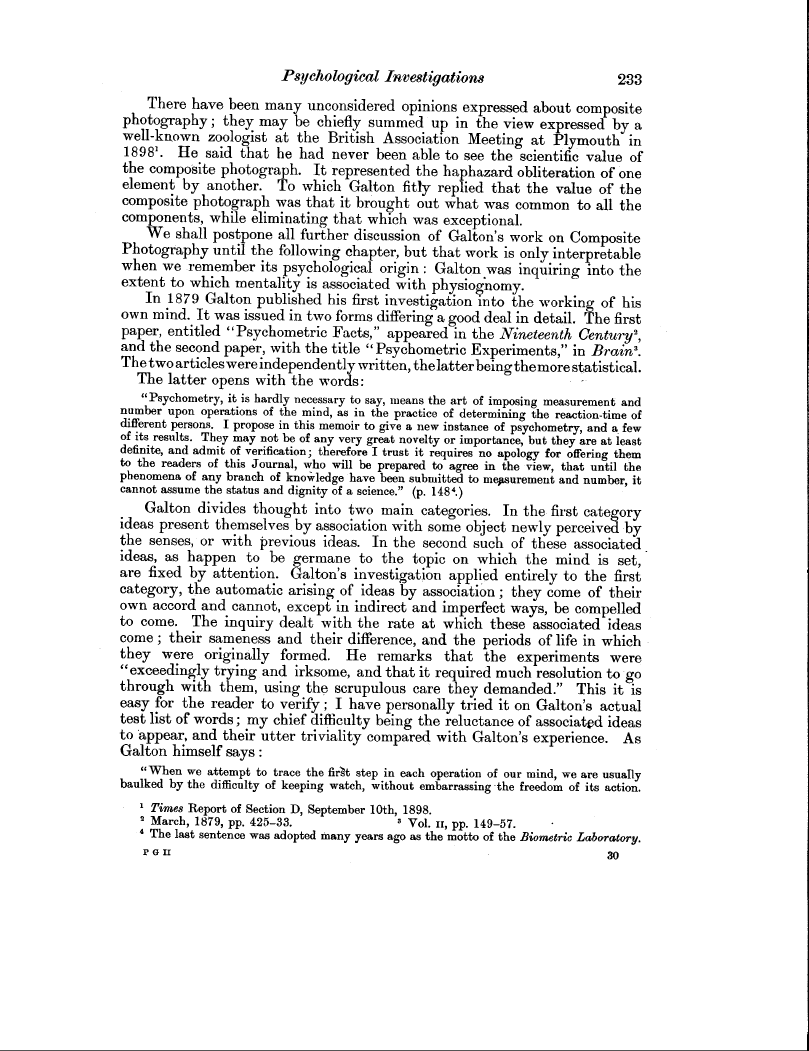Psychological Investigations 233
There have been many unconsidered opinions expressed about composite photography ; they may be chiefly summed up in the view expressed by a well-known zoologist at the British Association Meeting at Plymouth in 1898'. He said that he had never been able to see the scientific value of the composite photograph. It represented the haphazard obliteration of one element by another. To which Galton fitly replied that the value of the composite photograph was that it brought out what was common to all the components, while eliminating that which was exceptional.
We shall postpone all further discussion of Galton's work on Composite Photography until the following chapter, but that work is only interpretable when we remember its psychological origin : Galton was inquiring into the extent to which mentality is associated with physiognomy.
In 1879 Galton published his first investigation into the working of his own mind. It was issued in two forms differing a good deal in detail. The first paper, entitled "Psychometric Facts," appeared in the Nineteenth Century, and the second paper, with the title "Psychometric Experiments," in Brain'. The two articles were independently written, thelatterbeing the more statistical.
The latter opens with the words:
"Psychometry, it is hardly necessary to say, means the art of imposing measurement and number upon operations of the mind, as in the practice of determining the reaction-time of different persons. I propose in this memoir to give a new instance of psychometry, and a. few of its results. They may not be of any very great novelty or importance, but they are at least definite, and admit of verification; therefore I trust it requires no apology for offering them to the readers of this Journal, who will be prepared to agree in the view, that until the phenomena of any branch of knowledge have been submitted to measurement and number, it
cannot assume the status and dignity of a science." (p. 148'.)
Galton divides thought into two main categories. In the first category ideas present themselves by association with some object newly perceived by the senses, or with previous ideas. In the second such of these associated ideas, as happen to be germane to the topic on which the mind is set, are fixed by attention. Galton's investigation applied entirely to the first category, the automatic arising of ideas by association ; they come of their own accord and cannot, except in indirect and imperfect ways, be compelled to come. The inquiry dealt with the rate at which these associated ideas come ; their sameness and their difference, and the periods of life in which they were originally formed. He remarks that the experiments were "exceedingly trying and irksome, and that it required much resolution to go through with them, using the scrupulous care they demanded." This it is easy for the reader to verify ; I have personally tried it on Galton's actual test list of words; my chief difficulty being the reluctance of associated ideas to appear, and their utter triviality compared with Galton's experience. As Galton himself says
"When we attempt to trace the first step in each operation of our mind, we are usually baulked by the difficulty of keeping watch, without embarrassing -the freedom of its action.
1 Times Report of Section D, September 10th, 1898.
2 March, 1879, pp. 425-33. 3 Vol. ii, pp. 149-57.
4 The last sentence was adopted many years ago as the motto of the Biometric Laboratory.
Pall 30

